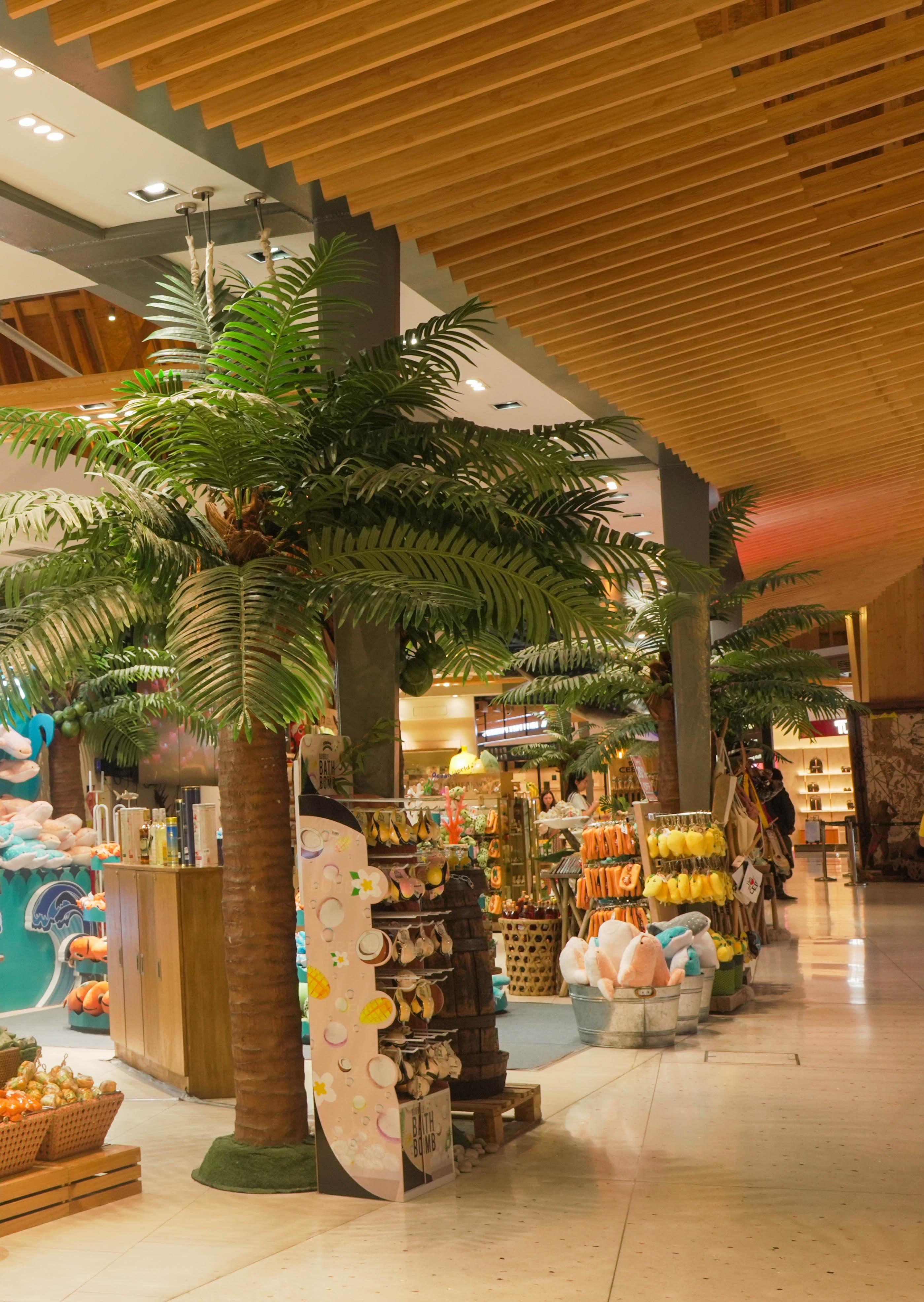TRANSFORMING TRAVEL: MCIA ELEVATES PHILIPPINE AVIATION







DIRECTED BY: GARY SMITH








DIRECTED BY: GARY SMITH
When Athanasios Titonis stepped into the role of CEO at Mactan–Cebu International Airport (MCIA) following the Aboitiz Group’s full acquisition of GMR-Megawide Cebu Airport Corporation (GMCAC), he brought with him not just experience, but vision. His mission was bold: to position MCIA as the Philippines’ premier tourism and transit hub. Just two years on, that vision is rapidly becoming reality.
From record passenger growth and international route expansion to pioneering digital innovation and sustainability practices, MCIA has become a shining example of what a modern airport can achieve when infrastructure, technology, and purpose align. Titonis’s leadership has placed Cebu, not Manila, at the centre of the Philippines’ aviation and tourism growth story.
“When I joined as CEO, the vision was clear,” Titonis explains. “Cebu is strategically located
in the heart of the Philippines. It had the potential to become the country’s main tourism gateway. Our job was to unlock that potential.”
Among the most high-impact initiatives under Titonis’s tenure are three interlinked programs: CEBu Connects, CEBu+, and CEBBalik. Each represents a different facet of MCIA’s mission: efficiency, accessibility, and social responsibility. The team set to work immediately, rolling out ambitious projects that would redefine inter-island travel.
CEBu Connects has radically improved transfer efficiency. By streamlining interterminal links, it allows connectivity time as short as 35 minutes for domestic and 60 minutes for international connections— helping position MCIA as a serious hub contender. “With CEBu Connects, we’ve built something beyond infrastructure. We’ve created a genuine hub, one that rivals even Metro Manila for connectivity and convenience,” says Titonis.


CEBu+ extends that convenience beyond the tarmac. This future initiative aims to bridge air and sea travel by integrating ferry services directly into the airport ecosystem. Once implemented, passengers will be able to travel from their flight to a high-speed boat to nearby destinations like Bohol and Camotes in just minutes. This unlocks the full value of island-hopping tourism and connects isolated communities with the global travel economy.
CEB-Balik, meanwhile, is a social project with real emotional weight. Designed specifically for Overseas Filipino Workers (OFWs)—many of whom hail from Visayas and Mindanao—it simplifies homecomings by offering direct flights, dedicated service counters, and future plans for on-site government kiosks. For many Filipinos, MCIA is no longer just a waypoint—it’s the warm welcome home.
MCIA has experienced record-breaking growth under Titonis’s leadership, with passenger numbers soaring well beyond pre-pandemic levels. What’s driving the surge?
“It’s a mix of strategy, partnership, and customer focus,” he explains. “We’ve worked closely with airlines, tourism boards, and government partners to reestablish key routes, open new ones, and ensure that passengers choose Cebu, not just for the beaches, but because the journey itself is better here.”
That strategy is paying off. With new direct international flights to cities like Ho Chi Minh (formerly Saigon)and regional access expanding rapidly, MCIA is redefining what it means to fly through the Philippines. Passengers are no longer merely transiting, they're choosing to arrive, depart, and connect through Cebu because of the airport’s growing reputation for comfort, efficiency, and hospitality.
To sustain this momentum, MCIA is doubling down on sustainability and smart airport development. The future isn’t just about growing, it’s about growing responsibly.
Rapiscan, part of OSI Systems, is a leading global provider of security inspection solutions, with more than 100,000 products installed in over 170 countries. Rapiscan has an extensive portfolio of Baggage and Parcel Inspection, Cargo and Vehicle Inspection, Hold Baggage Screening, People Screening, Trace Detection, Radiation Detection, Optical Inspection, Tray Return System and enhanced security solutions, which are supported by a global service network.
The company’s state-of-the-art products, solutions and services operate in the world’s most demanding security environments, including at airports, border crossings, railway stations, seaports, government and military installations and high-risk facilities. Rapiscan promotes excellence in security and efficiency, continually investing in research to develop technological advancements that address present and future threats and meet the most rigorous compliance standards worldwide.
One of Rapiscan’s leading products is the RTT 110®, an Industry leading high speed Explosive Detection System (EDS). With its stationary gantry it does not suffer from costly maintenance common with rotating gantries. It benefits from fewer moving parts and built in redundancy designed to ensure the highest levels of system availability for the most demanding aviation security environments. The intuitive user interface provides comprehensive diagnostic and report management and can be accessed locally or via Rapiscan®’s offsite service network.
The RTT®110 is revolutionizing the EDS market by providing exceptional performance and significantly lower cost of ownership. The RTT®110 produces high quality 3D images, delivered to the level 2 screener typically before the item has even left the machine.

More than just a transport hub, MCIA is playing a central role in boosting Cebu and the wider Central Visayas region’s economy.
“Every new route, every improved process, creates a ripple effect,” says Titonis. “From tourism and hospitality to logistics and trade, MCIA acts as an economic multiplier.”
MCIA is now responsible for funnelling close to 12 million passengers annually into a region renowned for its white-sand beaches, historical landmarks, and dive spots. In doing so, the airport contributes not only to national GDP but to regional equality by driving tourism beyond traditional centres like Metro Manila.
And it’s getting global recognition for its efforts. MCIA was recently awarded the Platinum Award in the Green Airport Category and named Best Airport in Asia-Pacific for airports serving 5 to 15
rubner.com/holzbau
million passengers by Airports Council International (ACI), testament to both its environmental leadership and customer service excellence.
The 2024 Airport Service Quality (ASQ) Award was especially significant, it was based on real-time passenger feedback, collected independently from travellers themselves. It represents a milestone not just for MCIA, but for the country.
ACI World Director General Justin Erbacci praised MCIA’s commitment to excellence, stating: “Flying through MCIA is more than just a journey; it’s a carefully crafted experience.” For Titonis, that recognition affirms everything his team has been working toward. “I am tremendously grateful to the MCIA team for delivering to its promise of excellence in customer experience,” he said. “This win is key in our vision of becoming the main tourism and transfer gateway in the country.”



Local pride was equally evident. “We have always been proud of what MCIA has accomplished and how it brings pride to Cebuanos,” said MCIAA General Manager Julius Neri. “Now, it has brought pride beyond Cebu but also for the entire Philippines.”
MCIA’s transformation coincides with its full transition under Aboitiz InfraCapital (AIC), marking a distinct shift in strategic priorities.
“We deeply respect the foundations built under the previous PPP,” says Titonis, “but our current roadmap reflects a more holistic and long-term vision. It’s about building a smart, sustainable, future-ready mobility ecosystem.”
This approach is more than just rhetoric. Under Titonis’s leadership, MCIA has implemented a customer-centric model that places passenger needs at the centre of every operational decision. The result? Global accolades for service quality, including a Skytrax 4-Star Terminal Rating and multiple ACI accreditations for accessibility and customer experience.
Importantly, AIC’s leadership also brings scale. MCIA now sits alongside Bohol–Panglao and Laguindingan airports within the Aboitiz portfolio, allowing for unified planning, standardised service delivery, and shared innovation across major regional hubs.
MCIA recently signed a masterplan agreement with Ricondo Associates, one of the world’s leading aviation consultants. This new blueprint sets out a phased, strategic expansion roadmap designed to support both near- and long-term passenger growth.
“This isn’t just about more runways or bigger terminals,” says Titonis. “It’s about building a truly integrated connectivity hub that meets international standards, supports tourism and trade, and delivers a seamless, enjoyable travel experience.”
The masterplan, expected to be finalised by July 2025, includes upgrades in


operational systems, security, and terminal design. It also lays the groundwork for improved intermodal connectivity, expanding the CEB+ sea-air integration and reducing congestion in Metro Manila by positioning Cebu as a viable alternative for inbound international flights.
In June 2025, MCIA earned another international acclaim after being ranked 7th among the World’s Most Improved Airports in the 2025 Skytrax World Airport Awards. This major recognition, presented by the prestigious UK-based aviation consultancy Skytrax—widely regarded as the “Oscars of the aviation industry”—puts MCIA in the company of global hubs that have achieved remarkable progress in infrastructure, passenger experience, and service excellence. Skytrax is the international gold standard for airport and airline excellence, known for its independent, passenger-driven reviews and global
benchmarking. The award highlights MCIA’s growth as a world-class airport and shows Cebu’s growing importance on the global stage.)
“This recognition is a testament to our commitment to continuous improvement. It also affirms our vision of positioning MCIA not just as a gateway, but as a worldclass destination in itself.” said Athanasios Titonis, CEO of Aboitiz InfraCapital Cebu Airport Corporation.
With significant progress already underway, MCIA continues to expand its connectivity by targeting longer-haul markets such as Australia, India, Middle East and the US while growing existing networks in South Korea and Japan. New Retail, Food and Beverage offers are also in plan with the opening of T2 Airport Village by 2025. They have even started a digitized way of ordering food inside the airport by partnering with Grab.


Central Visayas is a stunning region in the Philippines, known for its unique blend of breathtaking natural landscapes, rich history, and vibrant culture. Serving as the gateway to this tropical paradise, Mactan–Cebu International Airport (MCIA) plays a pivotal role in facilitating access to the many wonders of the Central Visayas region. With a combination of pristine beaches, captivating dive spots, historic landmarks, and a thriving local culture, this region offers an unforgettable experience for every kind of traveller.
Cebu: The Queen City of the South
Cebu, the heart of Central Visayas, is often hailed as the "Queen City of the South" due to its historical significance, economic prominence, and vibrant tourism offerings. Cebu is one of the most popular tourist destinations in the Philippines, with a variety of attractions ranging from modern urban settings to quiet, idyllic beaches.
The island’s historical landmarks, such as Magellan’s Cross, Fort San Pedro, and Basilica Minore del Santo Niño, draw visitors interested in the country’s rich Spanish colonial past. Cebu is also the birthplace of Christianity in the Philippines, and these sites provide fascinating insights into the country’s cultural and religious heritage. Visitors can walk the streets of Colon Street, the oldest street in the Philippines, while soaking in the colonial architecture that has been preserved for centuries.
Cebu’s beaches are another major draw. Mactan Island, accessible directly from MCIA, is renowned for its luxurious beach resorts and world-class diving spots. Visitors can enjoy water activities such as snorkelling, diving, and island hopping, or simply relax on the powdery white sands. The Mactan Shrine, dedicated to the historic Battle of Mactan between the forces of Portuguese explorer Ferdinand Magellan and local chieftain Lapu-Lapu, also draws tourists for its historical significance.
A short ferry ride from Cebu takes visitors to Bohol, a paradise island known for
its picturesque landscapes and unique natural wonders. The region is famous for the Chocolate Hills, a geological formation consisting of over 1,200 symmetrical mounds that turn brown during the dry season, giving them their chocolate-like appearance. Visitors can climb up viewing platforms to take in the panoramic view of this UNESCO World Heritage site.
Bohol is also home to the Tarsier Sanctuary, where tourists can observe one of the world’s smallest primates, the Philippine tarsier, in its natural habitat. The sanctuary offers an educational experience about the conservation of these fascinating creatures. For those seeking relaxation, Panglao Island is known for its tranquil beaches, clear waters, and vibrant coral reefs that attract divers and snorkelers from around the world. Alona Beach, in particular, is famous for its lively atmosphere, restaurants, and bars.
For adventure seekers, the Loboc River Cruise offers a scenic boat ride through lush jungles, complete with a buffet lunch and live music performances. The river, surrounded by thick tropical forests, provides an escape into nature, with the opportunity to see a variety of bird species, including the Philippine eagle.
Often overlooked in favour of its more famous neighbours, Siquijor has gained a reputation as a mystical and enchanting destination. The island is known for its traditional healing practices and its association with witchcraft and mysticism, which add an air of intrigue for visitors. Siquijor is home to a number of hidden gems, including the Cambugahay Falls, a series of cascading waterfalls surrounded by lush vegetation where visitors can swim in the cool, fresh water or try the famous rope swing.
The island also boasts pristine beaches and dive spots, particularly around Salagdoong Beach, which offers crystal-clear waters and vibrant coral gardens. The Siquijor Butterfly Sanctuary is another must-visit attraction, offering a closer look at the local fauna and flora.




Despite its mystical reputation, Siquijor is a peaceful escape for those looking to unwind. The island offers laid-back resorts, perfect for a quiet retreat with nature at your doorstep.
Another standout destination in Central Visayas is Dumaguete, the capital of Negros Oriental. Known as the “City of Gentle People,” Dumaguete offers a blend of natural beauty and cultural heritage. The city is home to the Silliman University, the oldest American university in the Philippines, which adds a youthful vibe to the city, with its vibrant student population contributing to the local art scene and café culture.
Dumaguete is also the gateway to Apo Island, a world-renowned diving destination known for its incredible coral reefs and sea turtle population. Divers flock to the island to experience its clear waters and healthy marine ecosystem. Back on the mainland, visitors can explore the Dumaguete Boulevard, a waterfront promenade where locals and tourists gather for leisurely walks or dining at the many restaurants and bars that line the area.
Bantayan Island: Off-the-Beaten-Path Retreat
For those seeking an unspoiled, peaceful retreat, Bantayan Island is the perfect destination. Located at the northern tip of Cebu, Bantayan is known for its serene atmosphere, crystal-clear waters, and uncrowded beaches. The island offers various beach resorts, perfect for those looking to escape the hustle and bustle of city life. Visitors can also enjoy fresh seafood, explore quaint local villages, or go island hopping to nearby Kalanggaman Island, known for its long sandbars and tranquil waters.
Central Visayas offers the perfect blend of adventure, culture, and relaxation. Whether you’re diving into the underwater world of the Tubbataha Reefs Natural Park, trekking through jungles to discover hidden waterfalls, or simply basking in the sun on a pristine beach, this region provides something for every traveller.
With MCIA as the key entry point, Central Visayas is positioned as the premier destination for anyone looking to explore the true beauty of the Philippines. From Cebu's bustling city life to Bohol’s natural wonders, Siquijor’s mystique, and Dumaguete’s charm, there’s no shortage of attractions to discover. For those looking for a getaway that combines rich culture, untouched nature, and warm hospitality, Central Visayas is undoubtedly the place to be.


MCIA’s success has also drawn praise for its operations team, which has embraced a “service-first” mindset across all departments. From ground handlers and security to retail and immigration, staff at MCIA are being retrained and empowered to view every passenger interaction as part of a world-class experience.
“We say it internally: every bag, every boarding pass, every hello, it matters,” says one MCIA senior manager. “Because to the traveller, that moment might define their whole journey.”
Training programmes now include customer empathy modules, cultural sensitivity, and crisis response simulations, ensuring frontliners are not only skilled but emotionally attuned to the needs of diverse travellers.
In an industry under pressure to
decarbonise, MCIA is positioning itself as a leader in airport sustainability.
“We’ve embedded sustainability into our DNA,” says Titonis. “It’s in our architecture, our operations, even the way we light our runways.”
MCIA has reduced the lighting energy consumption by up to 75% through the use of LED lighting, solar-powered systems, and automated building management tools. Airside, they’ve deployed Bridge Mounted Equipment (BME) and Electric Ground Support Equipment (e-GSE), setting the benchmark for eco-friendly operations in the Philippines.
Their efforts were recognised in 2024 with a Level 1 Airport Carbon Accreditation, the first airport in the country to achieve the milestone. In 2025, the airport’s ECO-Watt programme was featured in ACI Asia-

Pacific’s global publication on sustainable airport practices.
“These aren’t one-off wins,” Titonis emphasises. “They’re part of a long-term sustainability roadmap designed in collaboration with regulators, airlines, and local stakeholders.”
As one of the busiest airports in the country, MCIA faces a delicate balancing act: grow fast, but grow right.
For Titonis, it’s about marrying expansion with empathy. “We’re not just building more infrastructure. We’re building better experiences.”
One such initiative is the “silent airport” programme, which limits unnecessary
announcements to create a calmer travel environment. MCIA also gathers ongoing passenger feedback through its Airport Users Forum, ensuring every new development addresses real traveller needs.
The airport’s emphasis on continuous feedback has allowed it to rapidly adapt—from seating arrangements and queue management to signage and mobile services. “It’s not a static project,” Titonis explains. “An airport is like a living organism. If you listen, it will tell you how to improve.”
Titonis’s leadership style is deeply peoplefocused. “Empowerment, alignment, and purpose,” he says. “That’s how we lead here.”

Under his watch, MCIA has cultivated a performance-driven culture grounded in the Aboitiz values: innovation, integrity, teamwork, and responsibility. It’s a culture that expects excellence, but supports it too.
“We don’t just aim to meet global standards, we aim to set them,” he says. And with a string of awards, successful infrastructure rollouts, and a deeply engaged workforce, MCIA is well on its way.
Looking to the future, Titonis sees success as twofold: passenger numbers and purpose. By 2030, he aims to increase transfer traffic to over 20% of total volume, cementing MCIA’s status as a genuine hub for Southeast Asia.
But legacy, for him, is more personal.
“I want Aboitiz to be globally recognised as a world-class airport operator,” he says. “I want the airports we manage; Cebu, Bohol, Laguindingan, to be known not just for what they built, but how they served. For sustainability. For excellence. For heart.”
And with Cebu leading the charge, that legacy is well on its way to becoming a landmark in Philippine aviation history.
www.mactancebuairport.com
